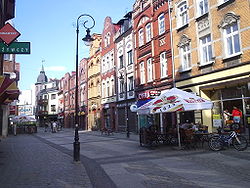Lębork
| Lębork | ||
|---|---|---|

Staromiejska Street
|
||
|
||
| Motto: Miasto z Europejską klasą European style town |
||
| Coordinates: 54°33′N 17°45′E / 54.550°N 17.750°E | ||
| Country |
|
|
| Voivodeship | Pomeranian | |
| County | Lębork County | |
| Gmina | Lębork (urban gmina) | |
| Town rights | 1341 | |
| Government | ||
| • Mayor | Witold Namyślak | |
| Area | ||
| • Total | 17.86 km2 (6.90 sq mi) | |
| Highest elevation | 46 m (151 ft) | |
| Lowest elevation | 17 m (56 ft) | |
| Population (2006) | ||
| • Total | 35,069 | |
| • Density | 2,000/km2 (5,100/sq mi) | |
| Time zone | CET (UTC+1) | |
| • Summer (DST) | CEST (UTC+2) | |
| Postal code | 84–300 to 84–310 | |
| Area code(s) | +48 59 | |
| Car plates | GLE | |
| Website | http://www.lebork.pl | |
Lębork ([ˈlɛmbɔrk]; Kashubian: Lãbòrg; German: ![]() Lauenburg in Pommern ) is a town of 37,000 people on the Łeba and Okalica rivers in the Gdańsk Pomerania region in northwestern Poland. Lębork is also the capital of Lębork County in Pomeranian Voivodeship since 1999, formerly the Słupsk Voivodeship (1975–1998) and Gdańsk Voivodeship (1945-1975).
Lauenburg in Pommern ) is a town of 37,000 people on the Łeba and Okalica rivers in the Gdańsk Pomerania region in northwestern Poland. Lębork is also the capital of Lębork County in Pomeranian Voivodeship since 1999, formerly the Słupsk Voivodeship (1975–1998) and Gdańsk Voivodeship (1945-1975).
The town was founded on the site of a previous Polish settlement named Łebno, later Germanised to Lewin and then Lewinburg by the invading Teutonic Knights In 1341 Dietrich von Altenburg, Grand Master of the Teutonic Knights, granted 100 Hufen (similar to hides) to Rutcher von Emmerich for the foundation of a town named Lewinburg (Lauenburg) with Kulm rights, presumably to secure the territory around Stolp (Słupsk). East of the original city the Teutonic Order completed the Ordensburg castle in 1363. The castle was partly razed after the 1410 Battle of Grunwald (Tannenberg) in 1410. In 1440 the town joined the Prussian Confederation. The population of Lauenburg was composed in large part of Kashubians, later Slovincians.
...
Wikipedia


